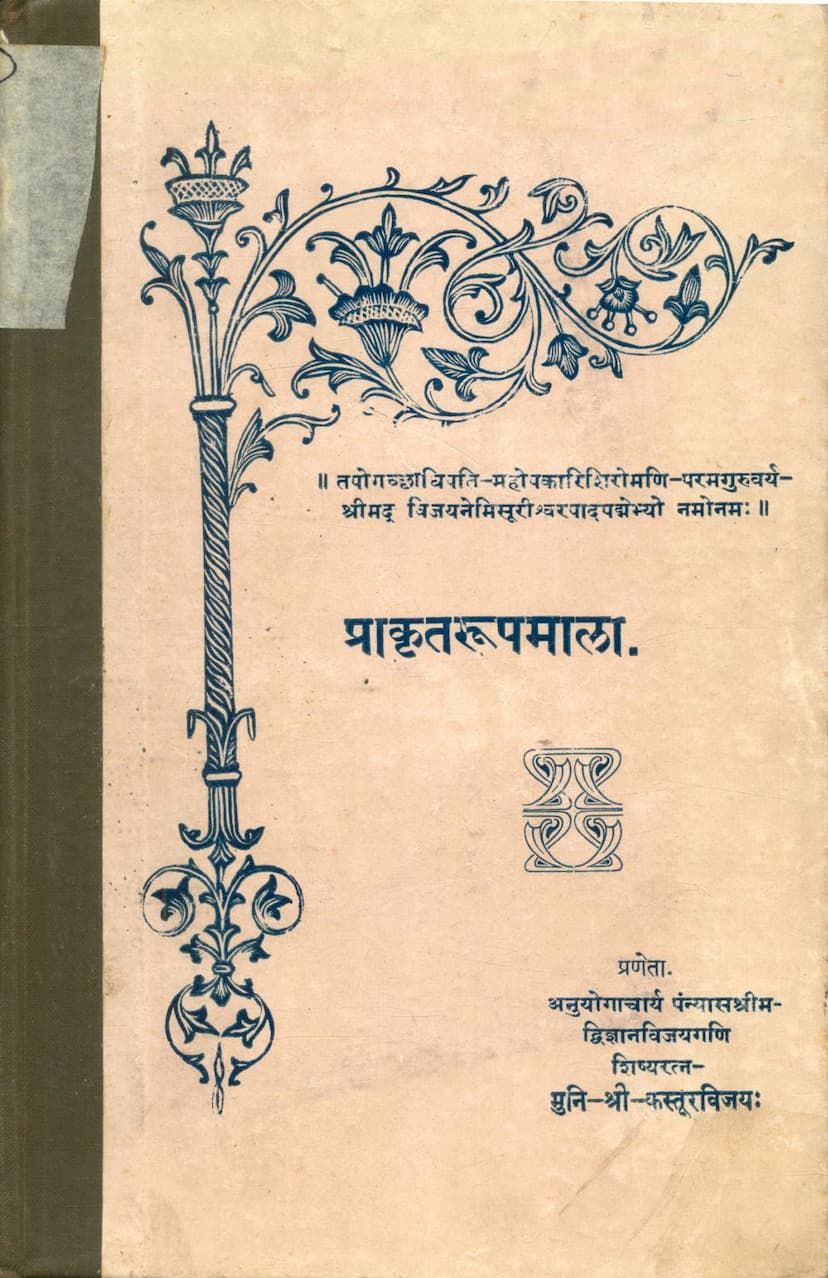Prakrit Rupmala
Added to library: September 2, 2025

Summary
Here is a comprehensive summary of the Jain text "Prakrit Rupmala" by Kasturvijay:
Book Title: Prakrit Rupmala (प्राकृतरूपमाला) Author: Muni Shri Kasturvijay (मुनि-श्री-कस्तूरविजय), disciple of Anuyogacharya Nyas Shri Vigyanvijayji Gani (अनुयोगाचार्य-पंन्यास-श्री-विज्ञानविजयजीगणी) Publisher: Vadilal Bapulal Shah (वडीललाल बापुलाल शाह), published by Shri Jain Granth Prakashak Sabha (श्री जैन ग्रन्थप्रकाशक सभा). Catalog Link: https://jainqq.org/explore/002256/1
Overall Purpose and Significance:
"Prakrit Rupmala" is a comprehensive grammar book focused on the Prakrit language, specifically compiled for the study and understanding of Jain literature. The author's intention is to provide a systematic and accessible resource for students of Prakrit, addressing the perceived lack of complete information in existing works. The book aims to cover various aspects of Prakrit grammar, including noun declensions, verb conjugations, sandhi rules, and other important grammatical elements.
Key Content and Structure:
The book is structured to systematically present Prakrit grammar, beginning with fundamental elements and progressing to more complex topics. The main sections include:
-
Noun Declensions (Shabda Rupa):
- Declension of ending in vowels like 'a', 'i', 'u', 'r', 'o', 'au'.
- Declension of words ending in consonants.
- Detailed forms of common noun classes such as 'Sarvadi' (सर्वदि) words, possessive words, and numerals.
- Examples are provided for each category, illustrating the declensions in all three genders (masculine, feminine, neuter) and all cases.
- The rules for these declensions are often explained in Gujarati, referencing the sutras from Acharya Hemachandra Suri's Prakrit Grammar.
-
Verb Conjugations (Dhatu Rupa):
- Conjugation of vowel-ending and consonant-ending verbs.
- Forms are presented for various tenses and moods, including present, future, imperative, past participle, and optative.
- The text covers active voice (Kartari Rupa), passive voice (Karmani Rupa), causative voice (Prerak Rupa), and derived forms.
- The formation of verb roots and the application of suffixes and rules are explained, again often referencing Hemachandra Suri's grammar.
-
Other Grammatical Topics:
- Sandhi Rules (Sandhi Niyam): Rules for combining sounds in Prakrit.
- Rules for forming Prakrit words from Sanskrit words (Sanskrit Shabdon Uparathi Prakrit Shabd Banavvana Samanya Niyamo).
- Taddhita (तद्धित): Rules for forming derived nouns and adjectives.
- Avyaya (अव्यय): Indeclinable words (adverbs, prepositions, etc.).
- Lingaanushasan (लिङ्गानुशासन): Rules of gender.
- Karak (कारक): Rules of case government.
- Kridanta (कृदन्त): Verbal participles and derived nouns.
- Shabdkosh (शब्दकोश): A vocabulary section, likely listing Prakrit words with their Sanskrit equivalents.
- Sanskrit-Prakrit Dhatukosh (संस्कृतादेशप्राकृतधातुकोश): A dictionary of verbs, explaining their Prakrit forms derived from Sanskrit roots, often with meanings.
- Prakrit Dhatuon ka Akaradi Kram (प्राकृत धातुओनो अकारादिक्रम): An alphabetical index of Prakrit verb roots.
Author's Motivation and Gurus:
The book is dedicated to Paramaguruvarya Shrimad Vijay Nemisurishwarji (परमगुरुवर्य-श्रीमद् विजयनेमिसूरीश्वरजी), the author's esteemed guru. The introduction also pays homage to Siddhantavachaspati, Nyayavisharad Acharya Shrimad Vijayoday Surishwarji (सिद्धान्तवाचस्पति-न्यायविशारद-आचार्य-श्रीमद्-विजयोदयसीश्वरेभ्यो), a prominent scholar and influence. The author, Muni Kasturvijay, is presented as a learned disciple who has mastered Prakrit grammar.
Publication and Sponsorship:
The book was published by the Shri Jain Granth Prakashak Sabha. It was sponsored by Shreshthi Nanalchand (श्रेष्ठी नहालचंद्र) of Pattanpuriya Jhaveri Pata, in memory of his deceased son, Maneklal (माणेकलाल). The printing was done at the 'Jain Advocate' press in Ahmedabad. This is noted as the first edition (Prathamaavritti), published in Veer Samvat 1452 / Vikram Samvat 1982 (corresponding to 1926 CE).
Philosophical and Linguistic Context:
The preface (Prastavana) highlights the importance of Prakrit as a foundational language in Jain literature. It emphasizes that Prakrit, derived from "Prakriti: Svabhavah" (nature, natural state), was the primary language of the ancient Indian populace and is prevalent in numerous Jain scriptures, including the Agamas and other works by revered acharyas. The text acknowledges the influence of Sanskrit and the need for Prakrit to be studied systematically, citing the work of Acharya Hemachandra Surishwarji as a precedent for grammatical study.
Key Features and Contributions:
- Systematic Presentation: Organizes Prakrit grammar logically, covering a wide range of word and verb forms.
- Rule-Based Learning: Provides grammatical rules, often cross-referenced with the authoritative work of Acharya Hemachandra.
- Practical Application: Offers numerous examples to illustrate grammatical principles, making it easier for students to grasp the nuances of the language.
- Comprehensive Coverage: Includes sections on declensions, conjugations, sandhi, taddhita, avyaya, karaka, and kridanta, along with dictionaries.
- Dedicated Scholarship: The work is a product of the author's deep study and devotion, intended to benefit the Jain community and promote the understanding of its scriptural heritage.
In essence, "Prakrit Rupmala" is a meticulous grammatical guide that serves as an invaluable tool for anyone seeking to engage with and understand the rich Jain literary tradition expressed in the Prakrit language.